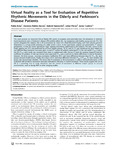Mostrar o rexistro simple do ítem
Virtual reality as a tool for evaluation of repetitive rhythmic movements in the elderly and Parkinson's disease patients
| dc.contributor.author | Arias, Pablo | |
| dc.contributor.author | Robles-García, Verónica | |
| dc.contributor.author | Sanmartín, Gabriel | |
| dc.contributor.author | Flores, Julián | |
| dc.contributor.author | Cudeiro, Javier | |
| dc.date.accessioned | 2015-04-28T07:38:42Z | |
| dc.date.available | 2015-04-28T07:38:42Z | |
| dc.date.issued | 2012-01-18 | |
| dc.identifier.citation | Arias P, Robles-García V, Sanmartín G, Flores J, Cudeiro J. Virtual reality as a tool for evaluation of repetitive rhythmic movements in the elderly and Parkinson's disease patients. PLoS One. 2012;7(1):e30021 | es_ES |
| dc.identifier.uri | http://hdl.handle.net/2183/14458 | |
| dc.description.abstract | [Abstract] This work presents an immersive Virtual Reality (VR) system to evaluate, and potentially treat, the alterations in rhythmic hand movements seen in Parkinson’s disease (PD) and the elderly (EC), by comparison with healthy young controls (YC). The system integrates the subjects into a VR environment by means of a Head Mounted Display, such that subjects perceive themselves in a virtual world consisting of a table within a room. In this experiment, subjects are presented in 1st person perspective, so that the avatar reproduces finger tapping movements performed by the subjects. The task, known as the finger tapping test (FT), was performed by all three subject groups, PD, EC and YC. FT was carried out by each subject on two different days (sessions), one week apart. In each FT session all subjects performed FT in the real world (FTREAL) and in the VR (FTVR); each mode was repeated three times in randomized order. During FT both the tapping frequency and the coefficient of variation of inter-tap interval were registered. FTVR was a valid test to detect differences in rhythm formation between the three groups. Intra-class correlation coefficients (ICC) and mean difference between days for FTVR (for each group) showed reliable results. Finally, the analysis of ICC and mean difference between FTVR vs FTREAL, for each variable and group, also showed high reliability. This shows that FT evaluation in VR environments is valid as real world alternative, as VR evaluation did not distort movement execution and detects alteration in rhythm formation. These results support the use of VR as a promising tool to study alterations and the control of movement in different subject groups in unusual environments, such as during fMRI or other imaging studies. | es_ES |
| dc.description.sponsorship | This work was supported by Xunta de Galicia (Consellería de Educación-2007/000140-0 and Dirección Xeral de I+D+i; 2010-2012), Spain. | |
| dc.description.sponsorship | Xunta de Galicia; 2007/000140-0 | |
| dc.language.iso | eng | es_ES |
| dc.publisher | PLoS ONE | es_ES |
| dc.relation.uri | http://dx.doi.org/10.1371/journal.pone.0030021 | es_ES |
| dc.rights | Creative Commons Attribution 4.0 International Licence (CC-BY 4.0) | es_ES |
| dc.rights.uri | http://creativecommons.org/licenses/by/4.0/ | |
| dc.title | Virtual reality as a tool for evaluation of repetitive rhythmic movements in the elderly and Parkinson's disease patients | es_ES |
| dc.type | info:eu-repo/semantics/article | es_ES |
| dc.rights.access | info:eu-repo/semantics/openAccess | es_ES |
Ficheiros no ítem
Este ítem aparece na(s) seguinte(s) colección(s)
-
GI-NEURO - Artigos [165]






